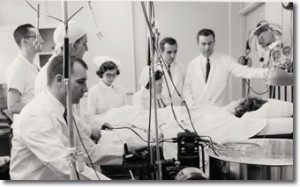Clinical
Division of Nephrology:
CLINICAL

The first dialysis procedure in the Commonwealth of Virginia was performed in 1959 by Division of Nephrology faculty at the University of Virginia. Since then, the division has been recognized for its excellence in treating kidney diseases.
The 2013-2014 U.S. News & World Report ‘Best Hospitals’ guide, recognized ten medical specialties at University of Virginia Health System as “high performing” (ranking among the top 25% in their specialty) – among them Nephrology. As the division’s reputation has grown over the last decade, as evidenced by such rankings, so has its clinical practice and patient referrals. This is reflected in a 49% increase in revenue and 44% increase in work RVUs over the last ten years. On average, the wRVU volume has increased 4.2% each year since 2005. The division has continued to expand its outreach through the establishment of new clinics and services in multiple locations in and around Charlottesville, providing care to patients from a wide swath of central Virginia and, through referrals, many more from elsewhere in Virginia and surrounding states – often for expert opinion, therapies (such as apheresis) and treatments (including experimental drugs) that are not available locally.
In a significant step to enhance dialysis access and quality of care for Southside Virginia patients, UVA Health System has partnered with Centra to establish new dialysis centers in Farmville and Appomattox. Read more here.
Outpatient Clinics
- Chronic Kidney Disease (CKD) clinics at Zion Crossroads, Piedmont and UVA Orange Dialysis facility
- Focused clinics:
- Kidney Stone Clinic at Augusta Medical Center
- Polycystic Kidney Disease Clinic at the UVA Kidney Center
- Rapid Access Clinic located at UVA Kidney Center; urgent referrals are seen within 24 to 48 hours
Inpatient Services
- Dialysis and consultation services at UVA HealthSouth and the Transitional Care Hospital
- Acute Kidney Injury (AKI) Risk Reduction Initiative has decreased the risk-adjusted incidence of AKI, with significant cost savings and reduction in hospital length-of-stay
Dialysis Program
For three years in a row (FY 2012, 2013, 2014), all eight UVA dialysis centers have earned “Five Diamond” status from the Mid-Atlantic Renal Coalition (MARC), a top patient-safety honor. Only 21 dialysis centers in Virginia have achieved five-diamond status. The division plans to add urgent-start peritoneal dialysis and ultrafiltration services in the near future.
Dialysis services currently offered:
- Home hemodialysis, including short daily hemodialysis and peritoneal dialysis, in Charlottesville, Fishersville, and Lynchburg
- Transitional Extracorporeal Care Unit (TECU), providing care for patients who require temporary outpatient dialysis for AKI, or apheresis, on an outpatient basis. TECU is one of the only facilities of this type in the U.S.
- Peritoneal dialysis (PD) increased by 34% over the past year
- Quality metrics are excellent, with peritonitis rates much lower than benchmark standards
- Peritoneal dialysis program was expanded to include Fishersville
- New faculty member, Sana Khan, MD, is providing focus for growth of PD program
- Launching in 2014: satellite hemodialysis units in Farmville and Appomattox
Transplant Program
The kidney transplant program at UVA, started in 1967, is currently one of the busiest in the state; it has performed more than 1,800 transplants to date. Kidney transplant recipients come from all over Virginia, from other states, and from other countries; many such referrals involve high-risk recipients or otherwise extremely challenging cases that require state-of-the-art diagnostic and therapeutic approaches. The transplant program offers innovative translational research protocols, including transplantation for sensitized patients (those who are both ABO-incompatible and cross match-positive with their only available live donor), as well as donor advocacy and support for altruistic live donation.
The division is working to strengthen its kidney transplant service through enhanced outreach efforts in regions across the state. Its newly renovated outpatient clinic in the West Complex will accommodate a higher volume of patient referrals, and the transplant nephrologist team expanded to consist of 5 full time nephrologists. The goal for the program is at least 125 active patient listings per year, with a target of 5 percent growth each year after 2013. In FY 2013, the program exceeded its forecasted number of transplants. To offset the decreased availability of deceased-donor organs, the program is striving to increase the number of living-donor transplantations.
